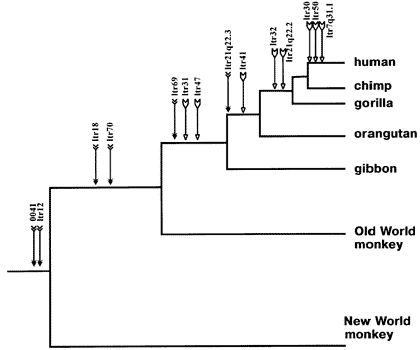I had no idea using the term "lawn" would generate such a lively discussion. Jeepers!
I am aware that a device known as "the Tree of Life" is used in the Kabala (new age version) and Tarot reading. My understanding is the Kabala originally was rooted from the Torah (Spanish) and of course the Tree of Life is mentioned in Genesis and Revelation as being in the center of Eden and Paradise respectively. That's one reason why I believe Eden is in the spiritual realm - but I digress...
Several of you seem to believe my "lawn" choice has already been disputed. But I'm not convinced by your assertions. I visualized a "lawn" when I saw this article:
We are accustomed to imagining scales of similarity ranging from 100% similar – that is to say, identical – to 0% similar, that is to say, totally different. This is the conceptual framework within which we interpret the 98.6% or whatever similarity of human and ape. They are really, really similar, almost identical. But in fact, DNA similarity is not structured in quite that way. There are, as everyone knows, only 4 bases in DNA. And this places an odd statistical constraint on the comparison of sequences. No DNA similarity at all – that is to say, two random sequences that share no common ancestry – are still going to match at one out of four sites. In other words, the zero mark of a DNA comparison is not zero percent similar, but 25% similar.
Once again, the DNA comparison requires context to be meaningful. Granted that a human and ape are over 98% genetically identical, a human and any earthly DNA-based life form must be at least 25% identical. A human and a daffodil share common ancestry and their DNA is thus obliged to match more than 25% of the time. For the sake of argument let’s say 33%.
The point is that to say we are one-third daffodils because our DNA matches that of a daffodil 33% of the time, is not profound, it’s ridiculous. There is hardly any biological comparison you can make which will find us to be one-third daffodil, except perhaps the DNA.
In other words, just as Simpson argued in the 1960s, the genetic comparison is exceptional, not at all transcendent. DNA comparisons overestimate biological similarity at the low end and underestimate it at the high end – in context, humans are biologically less than 25% daffodils and more than 98% chimpanzees.
The focus on base-pair mismatch itself is misleading, for it encodes a number of archaic assumptions about genetics and evolution. In fact, it ignores what is quite possibly the most significant development in biology in the last quarter-century – namely, the complexity of genome structure.
If humans and chimpanzees are over 98% identical base-for-base, how do you make sense of the fact that chimpanzees have 10% more DNA than humans? That they have more alpha-hemoglobin genes and more Rh bloodgroup genes, and fewer Alu repeats, in their genome than humans? Or that the tips of their chromosomes contain DNA not present at the tips of human chromosomes?
Obviously there is a lot more to genomic evolution than just nucleotide substitution. But the percentage comparison renders that fact invisible, and thus obscures some of the most interesting evolutionary genetic questions.
Once you recognize that there are easily identifiable differences genetically between humans and chimpanzees – the presence of terminal heterochromatin is 100% diagnostic – you can begin to see that the pattern of relationships between the species is actually the same genetically as anatomically. Humans and chimps are simply very similar to, yet diagnosably different from, one another.
